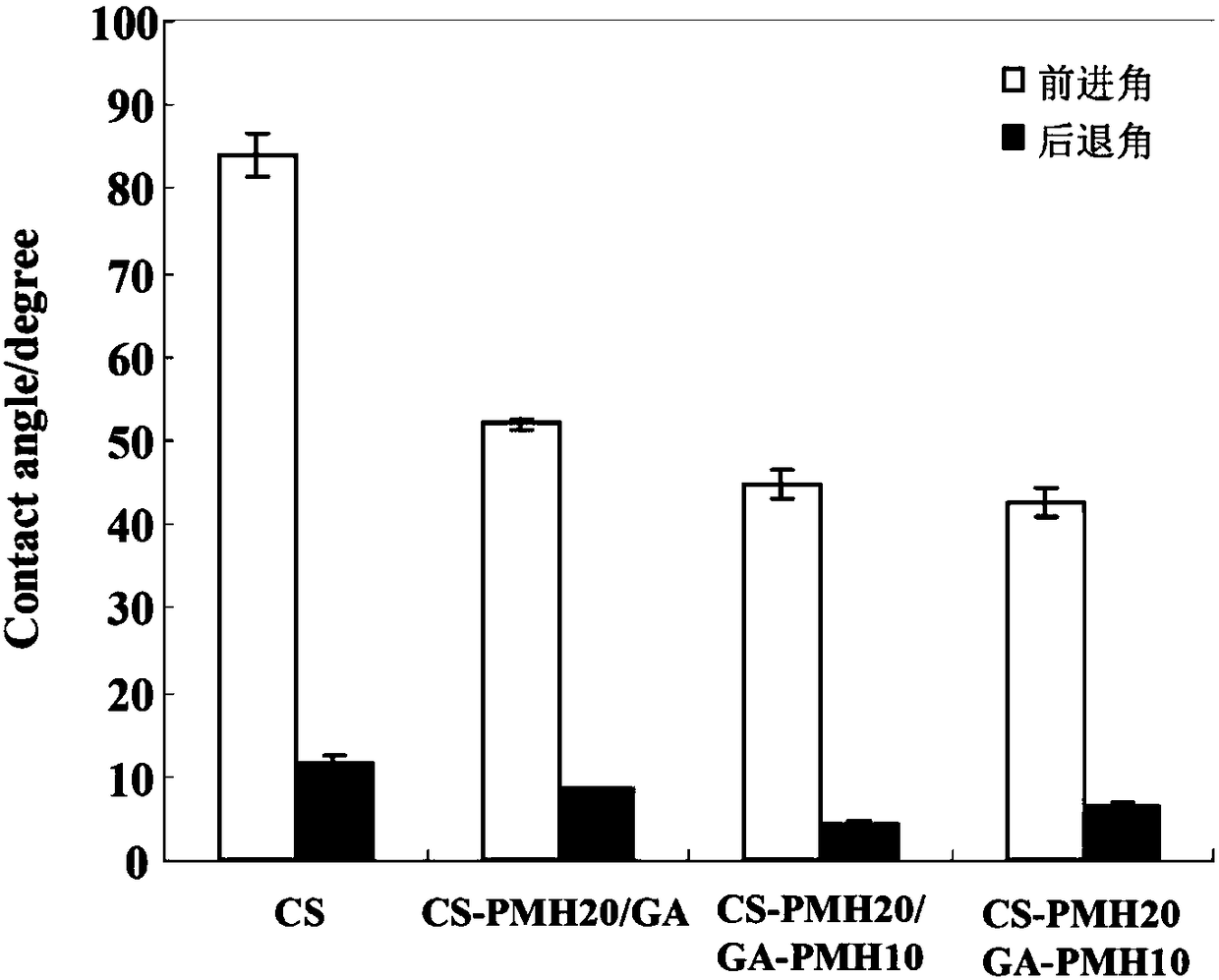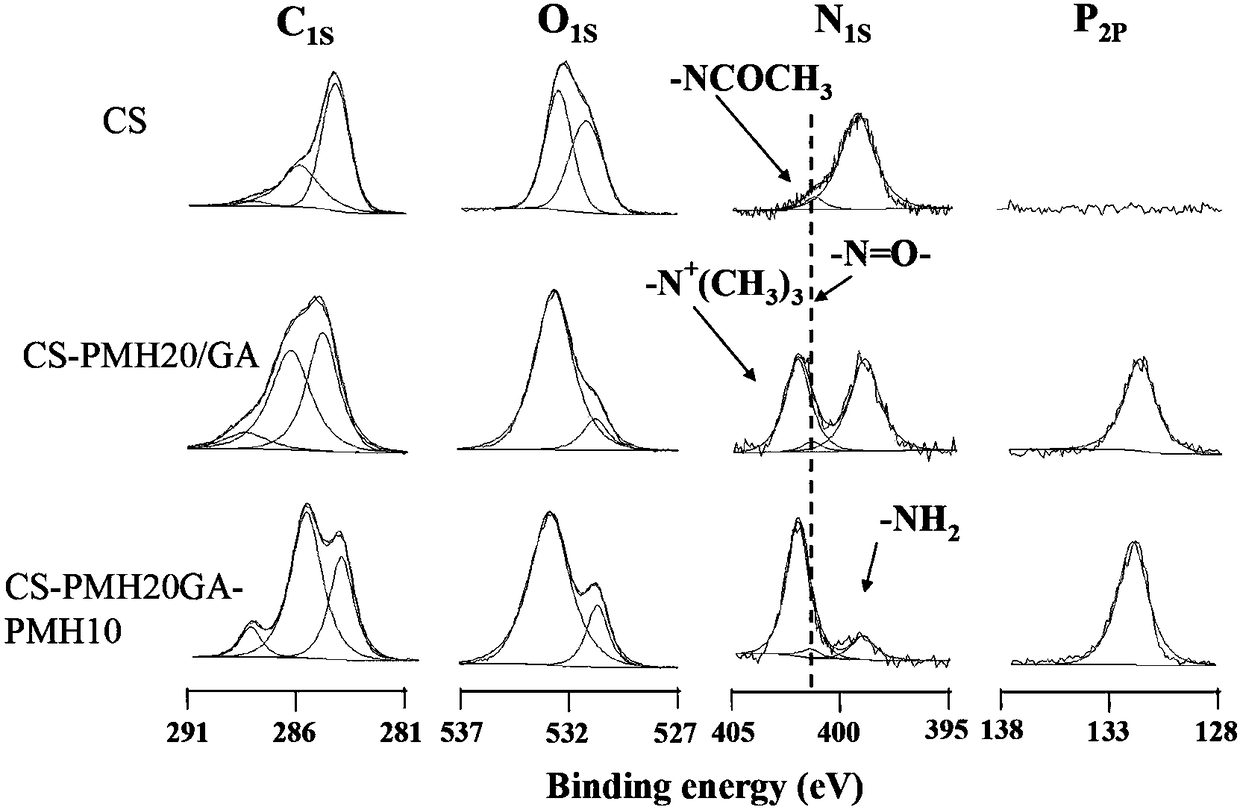Preparation method of imitation cell outer membrane structure coating with surface of phosphorylcholine
A technology that imitates the outer membrane of cells and phosphorylcholine, which is applied in the fields of liquid-coating devices, coatings, and medical sciences. The low density of acylcholine groups has achieved broad application prospects, the preparation method is simple, and the effect of improving performance
- Summary
- Abstract
- Description
- Claims
- Application Information
AI Technical Summary
Problems solved by technology
Method used
Image
Examples
Embodiment 1
[0031] Weigh 16mmol 2-methacryloyloxyethylphosphorylcholine and 4mmol 2-aminoethyl methacrylate hydrochloride, use 0.1mmol potassium persulfate as the initiator, and polymerize at 70°C under nitrogen protection After 24 hours, the reaction was dialyzed, and then freeze-dried at -50° C. to obtain an amino group-containing phosphorylcholine polymer PMH20 (20 represents 20% molar ratio of amino group vinyl monomer feed during polymer synthesis). Similarly, samples such as PMH10, PMH15 and PMH25 can be synthesized.
[0032] Using a 400MHz NMR instrument to D 2 O is the hydrogen NMR of the solvent test polymer. There is no peak at 5-7ppm, indicating that there is no residual monomer in the resulting copolymer, and the polymer has been successfully synthesized, with 3.28ppm being -N + (CH 3 ) 3 Characteristic peaks, 0.9-2.2ppm are the peaks of methylene and side chain methyl groups on the main chain to calculate the polymer composition, and it can be known that the polymer composi...
Embodiment 2
[0042] Weigh 17mmol 2-methacryloyloxyethylphosphorylcholine and 3mmol 2-aminoethyl methacrylate hydrochloride, use 0.1mmol potassium persulfate as the initiator, and polymerize at 70°C under nitrogen protection After 24 hours, the reaction was dialyzed, and then freeze-dried at -50°C to obtain an amino group-containing phosphorylcholine polymer.
[0043] The amino group-containing phosphorylcholine polymer and glutaraldehyde in this embodiment are dissolved in an ethanol solvent in a molar ratio of 100:5 according to the amino group and the aldehyde group. After mixing uniformly, the concentration of the amino group-containing phosphorylcholine polymer is 0.5mg / mL, coating 10μl / cm 2 / surface on the chitosan material surface to dry, and then the methanol solution of 2mg / mL PMH20 coating volume 5 microliters / cm 2 / surface, dried in the air, and then treated in distilled water at 80 degrees for 12 hours, and then washed with a large amount of methanol and distilled water in tu...
Embodiment 3
[0045] Weigh 12mmol 2-methacryloyloxyethyl phosphorylcholine and 8mmol 2-aminoethyl methacrylate hydrochloride, use 0.1mmol potassium persulfate as the initiator, and polymerize at 70°C under nitrogen protection After 24 hours, the reaction was dialyzed, and then freeze-dried at -50°C to obtain an amino group-containing phosphorylcholine polymer.
[0046] The amino group-containing phosphorylcholine polymer and glutaraldehyde in this embodiment are dissolved in methanol solvent in a molar ratio of 100:15 according to the amino group and the aldehyde group. After mixing uniformly, the concentration of the amino group-containing phosphorylcholine polymer is 2mg / mL, coating 10μl / cm 2 / surface on the chitosan material surface to dry, and then the methanol solution of 3mg / mL PMH15 coating volume 20 microliters / cm 2 / surface, dried in the air, and then treated in distilled water at 85 degrees for 11 hours, and then washed with a large amount of methanol and distilled water in tur...
PUM
 Login to View More
Login to View More Abstract
Description
Claims
Application Information
 Login to View More
Login to View More - R&D
- Intellectual Property
- Life Sciences
- Materials
- Tech Scout
- Unparalleled Data Quality
- Higher Quality Content
- 60% Fewer Hallucinations
Browse by: Latest US Patents, China's latest patents, Technical Efficacy Thesaurus, Application Domain, Technology Topic, Popular Technical Reports.
© 2025 PatSnap. All rights reserved.Legal|Privacy policy|Modern Slavery Act Transparency Statement|Sitemap|About US| Contact US: help@patsnap.com



